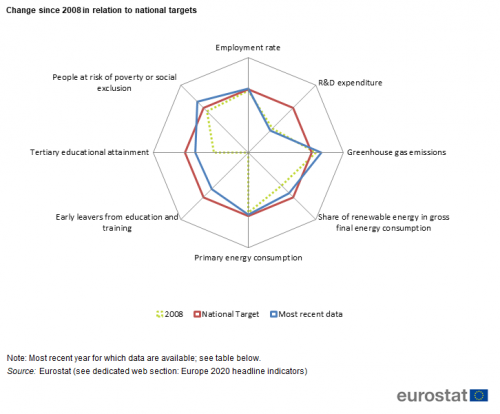Archive:Europe 2020 indicators - Portugal
Data extracted in June 2019. Planned article update: September 2020.

Source: Eurostat (see dedicated web section: Europe 2020 headline indicators)
Explanations on this radar chart are available here.
This article is part of a set of statistical articles on Europe 2020 strategy, focusing on the situation in Portugal.
Full article
Overview
By 2017, Portugal had reduced its GHG emissions in ESD sectors by 14.2 % compared with the ESD base year levels, remaining well below its target for no more than a 1 % increase by 2020. The country met its target on primary energy consumption between 2011 and 2016, but an increase in 2017 put it 0.3 Mtoe above its target. By 2017, Portugal had reduced the distance to its renewable energy target to 2.9 percentage points. In 2018, it met its employment target of 75 % for the first time. A 19.4 % reduction in the number of people at risk of poverty and social exclusion since 2008, meant Portugal met its national target for this goal in 2018. The country has achieved a notable reduction in the share of early leavers from education and training, narrowing the gap to its target by 23.1 percentage points between 2008 and 2018. Despite an 11.9 percentage point increase in tertiary educational attainment since 2008, the country was still 6.5 percentage points from its Europe 2020 target.

Source: Eurostat (see dedicated web section: Europe 2020 headline indicators)
Data sources
More information about the origin of the data and the calculation of indicators can be obtained via the Europe 2020 indicators dedicated website.
Under 'Main tables', click on the icons next to the indicators:
- 'Explanatory texts (metadata)' for a detailed overview of the collection and compilation methods;
- 'Information on the leaf' for data availability per country.
A more general overview of quality procedures can be found in Implementation of standard reference metadata for indicators - the ESMS Indicator Profile (ESMS-IP) (PDF file).
Context
Europe 2020 is the EU’s agenda for jobs and growth for the current decade. It emphasises smart, sustainable and inclusive growth as a way to strengthen the EU economy and prepare its structure for the challenges of the next decade. As a main objective, the strategy strives to deliver high levels of employment, productivity and social cohesion in the Member States, while reducing the impact on the natural environment.
Direct access to
- Smarter, greener, more inclusive - indicators to support the Europe 2020 strategy - 2019 edition (online publication, also downloadable as PDF file
- Towards robust quality management for European Statistics - Communication from the Commission to the European Parliament and the Council COM(2011) 211 final.
- Regulation (EC) No 223/2009 of 11 March 2009 on European statistics